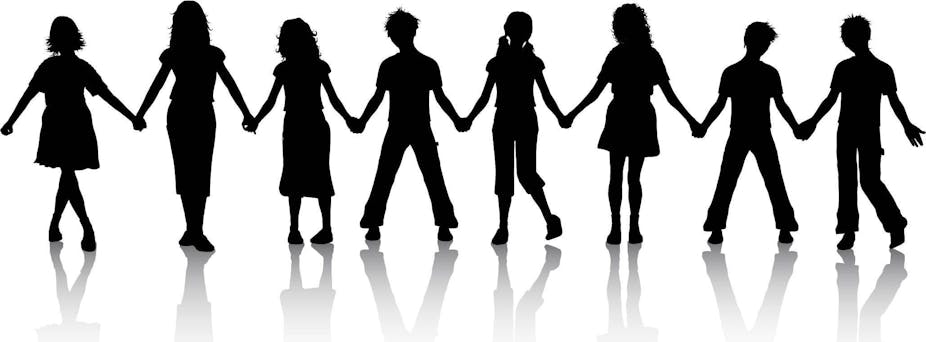The days of nuclear families consisting of mum, dad and 2.5 children are long gone – if they ever really existed. We now see families coming in many shapes and sizes, including with parents who are lesbian, gay, bisexual, transgender, intersex and single by choice. Such families are possible due to advances in fertility technology such as IVF and surrogacy.
The law is slowly catching up with these medical and social advances. In some Australian jurisdictions, it is now possible for people conceived using donor sperm and eggs to obtain information about their donor, even if the donor was promised anonymity when they provided the gametes. Such law reform recognises the strong urge in some people to know their genetic origins.
However, for some, this law reform has come too late, and records pertaining to the identity of their donor may no longer exist, or their donor may have passed away or not want any contact with their offspring conceived from their donation.
But making contact with the sperm or egg donor is not the end of the issue for donor-conceived individuals. Many are just as interested in reaching out to other biological kin, such as other offspring conceived using the same donor’s sperm or eggs.
A quest for knowledge about donor siblings (“diblings” for short) was the catalyst for the development of the Donor Sibling Registry in the US, in 2000. That there are almost 56,000 members from around the world on this registry is testament to the strong demand for such connections.
Research conducted with donor-conceived individuals found that they were more interested in meeting their diblings than their donor, perhaps because it was less likely to negatively impact on their relationship with their parents.
The main reasons given by donor-conceived individuals for wanting to find diblings were curiosity, a better understanding of their genetic identity and to avoid unwittingly forming incestuous relationships with them.
Australia lags behind the US when it comes to connecting diblings. There is no Australian equivalent to the Donor Sibling Registry (although many Australian donor-conceived people have registered on the US site, and some have been matched with their diblings).
Rather, Australia has a patchwork of processes and regulations relating to diblings. Victoria is the most progressive, with a Voluntary Register that helps donor-conceived individuals (or their parents if they are under 18), who both enter their details on the Voluntary Register, to connect.
The Victorian Assisted Reproductive Treatment Authority (VARTA) will contact all parties and invite them to exchange information if they wish. A deficiency of the Voluntary Register is that even if VARTA knows the identity of other offspring of the same donor, they cannot contact them to let them know there are diblings wanting to reach out to them. This is in stark contrast with the way the Central Register operates; VARTA does advise a donor that a donor-conceived child is seeking to contact them, even if the donor has not placed their details on the Central Register.
This distinction exists because the Central Register is required by legislation, whereas the Voluntary Register is not. Parliament has not yet recognised any right for diblings to connect with each other.
Associate professor Sonia Allan has developed a useful resource that sets out the divergent state and territory laws (or lack of laws) regulating contact between genetic kin. Queensland, Tasmania, the Northern Territory and the ACT have no legislation regulating contact between donor-conceived individuals and their donors, let alone their diblings. South Australia has legislation, but no register to facilitate connections.
The only national program connecting diblings is SybLink, a service offered by IVF Australia exclusively for people conceived through its clinics.
In the absence of accessible and reliable government-run systems for diblings to find each other, many donor-conceived people are turning to commercial enterprises such as Ancestory.com and 23andme. On these sites, for around A$100, they can order a DNA test that may lead to the identification of genetic relatives, including donors and diblings.
While there are happy outcomes for some people using these services – such as Cynthia Lund, who found a donor sister – these processes also raise serious concerns relating to privacy (a for-profit business has your DNA profile) and potential negative mental health outcomes for people who embark on this journey without the kind of support and counselling that experienced organisations like VARTA offer to all donor-conceived individuals and their parents.
Genealogy is a billion dollar industry, and according to Time magazine, genealogy websites are the second most-visited category of websites after pornography. This is evidence of the urge in many of us to know our biological origins.
For people conceived using donor gametes, this need to understand their genetic identity is not limited to finding out about their donor, but extends to other kin, such as diblings.
International human rights law recognises the right to identity (Article 8 of the Convention on the Rights of the Child), and that families should be assisted and protected (Article 10 of the International Covenant on Economic, Social and Cultural Rights).
Arguably, these human rights treaty provisions require Australia (which is a party to both these international treaties) to provide a safe, secure and regulated service for donor-conceived individuals to find any diblings they may have.
It is time for the states and territories to come to terms with the reality of modern families and develop a uniform legal framework that enables donor-conceived people to realise their right to know their genetic identity and, if they wish, form relationships with their genetic kin.

